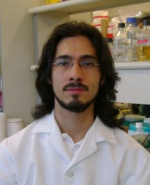Tomás de Paula e Silva
From DNA Repair Lab
←Older revision | Newer revision→
|
Third year Biology graduation student at IB/USP, Tomás works at the DNA Repair Lab since november, 2006. His Scientific Initiation project, which is supported by a FAPESP grant, is under prof. Carlos Menck's orientation and dr. Tatiana Ortolan's co-orientation. The project will use the RNAi technique for a study on the regulation of primary human cells' response to UVB-induced DNA damage. | |
|
[edit] Project AbstractAmong the responses of cells to DNA damage, such as those caused by ultraviolet radiation, DNA repair and apoptosis are of notice for allowing, respectively, restoration and elimination of damaged cells. The decision between these two different outcomes of DNA damage is made by a complex network of biochemical signals, and in this network the protein p53 plays a crucial role. Regulation of p53 activity in response to DNA lesions includes several feedback loops among which those formed with the protein Mdm2 are of great importance and have been studied as potential targets for anti-tumoral therapies. This project starts by characterizing the responses to UVB irradiation of cultured primary human fibroblasts from normal patients and from Xeroderma Pigmentosum (XP-C) and Cockayne Syndrome (CS-B) patients (both syndromes result from mutations in genes of the nucleotide excision repair pathways, which are the main means of UV damage removal by cells). These responses will be measured by cell viability and apoptosis assays. Responses of confluent (and thus quiescent) and sub-confluent (proliferating) cells will be compared. Following a protocol for siRNA transfection of the same cells will be optimized, and Mdm2 production will be silenced. The resulting effects on the cellular responses to UVB irradiation will be assayed and compared to untreated cells, which will allow further investigation of Mdm2 functions in DNA damage response regulation. This research project will thus include the development of experimental protocols of general use in the laboratory and a better characterization of Mdm2 properties in relevant processes in the cell. [edit] Publications | |
